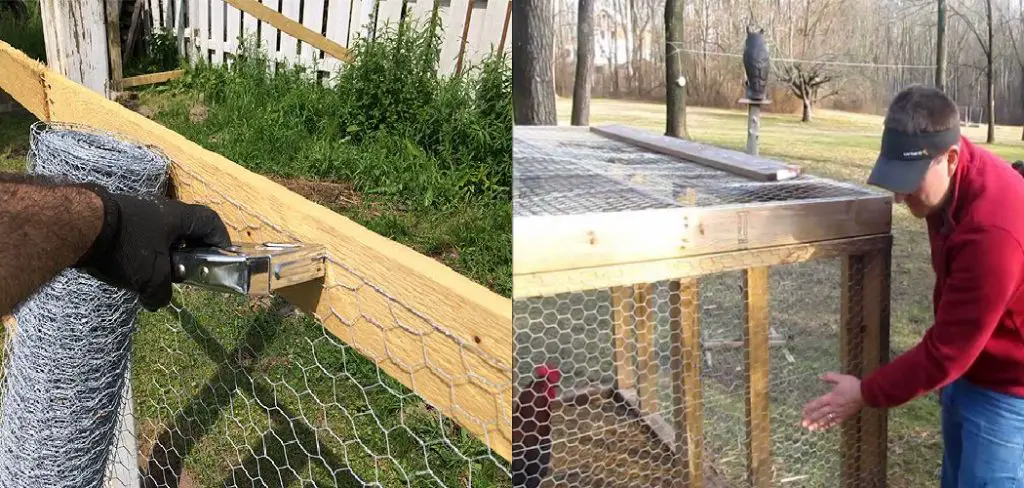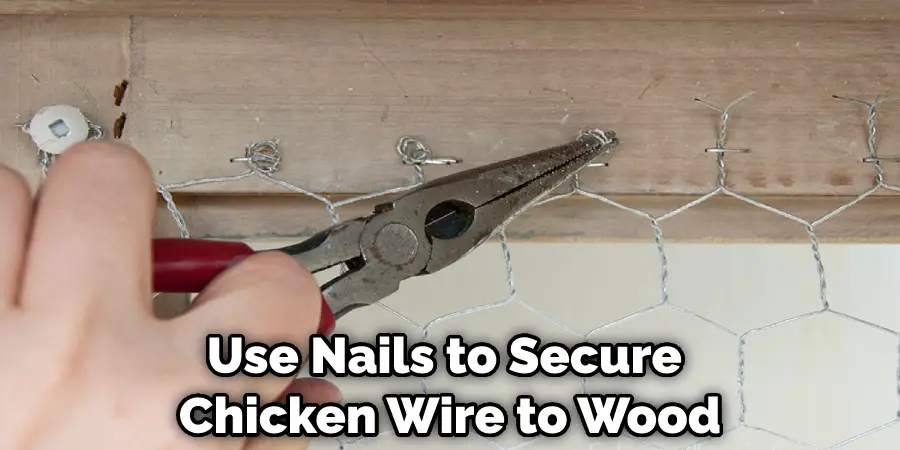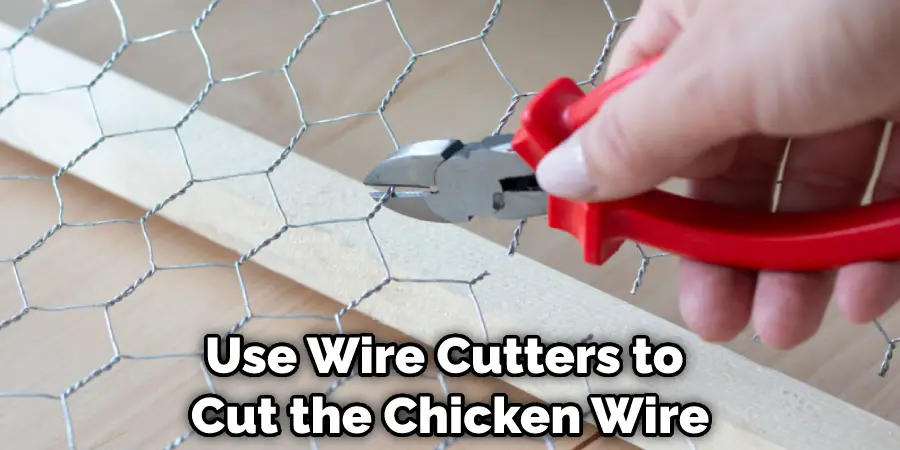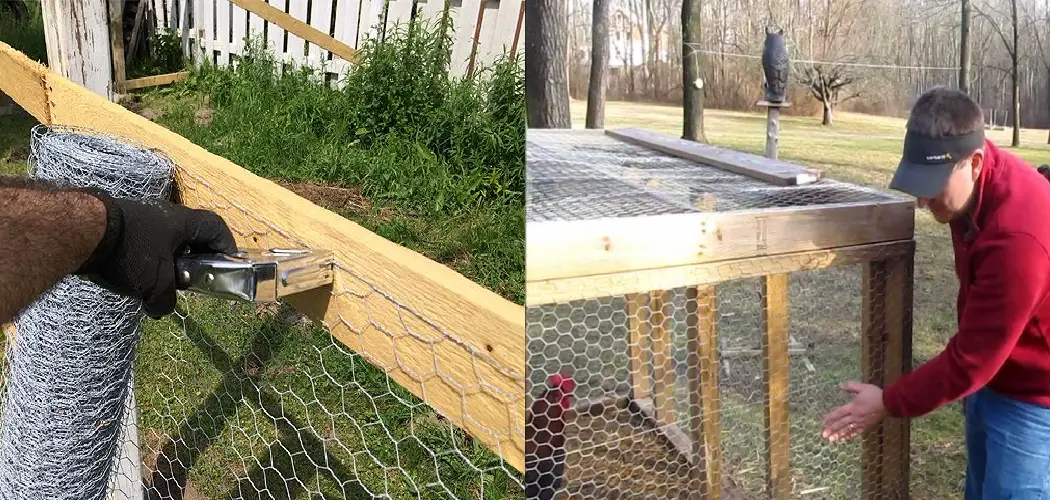If you have a chicken coop, you’ll need to secure the chicken wire to the wood to keep your chickens safe. Chicken wire is a versatile material that can be used for many projects around the home. If you need to secure chicken wire to wood, you can use a few different methods. This article will cover how to secure chicken wire to wood. We’ll also provide tips on which method is best for your project. So whether you’re building a chicken coop or just reinforcing some fencing, read on for the details.

What Reasons Did You Need to Secure Chicken Wire to Wood?
Chicken wire is popular for chicken coops because it’s strong and durable. It’s also a good option for other projects around the home, such as reinforcing fencing or creating a pet-proof barrier. In addition, chicken wire can effectively keep your chickens (or other animals) safely contained when used properly. There are many reasons to use chicken wire, but some of the most common reasons are listed below.
-To Keep Chickens (or Other Animals) Contained:
This is probably the most common reason for using chicken wire. Whether you’re looking to keep your chickens in (or predators out), chicken wire can be a helpful tool.
-To Reinforce Fencing:
If you have a fence that’s starting to sag or fall over, chicken wire can help reinforce it. Attach the chicken wire to the fence using staples or zip ties. If done properly, this can add years of life to your fence.
-To Create a Pet-Proof Barrier:
Chicken wire can also be used to create a pet-proof barrier. This is especially helpful if you have a dog that likes to dig or jump fences. By attaching chicken wire to the fence, you can create a much more difficult (and sometimes impossible) barrier for pets to get through.

-To Keep Birds Out:
Chicken wire can be a helpful tool if you’re trying to keep birds out of your garden. Build a frame out of chicken wire and attach it to your fence. The frame can be any size or shape, but it should be tall enough to deter birds from flying over it.
-To Keep Small Animals Out:
Chicken wire can also be used to keep small animals out of your garden or yard. This is especially helpful if you live in an area with many rabbits or other small pests. Build a chicken wire fence around the perimeter of your property.
-To Protect Plants:
If you have plants that you want to keep safe from animals, chicken wire can be a helpful solution. Build a frame out of chicken wire and place it around the plant. The frame can be any size or shape, but it should be tall enough to deter animals from getting to the plant.
-To Make a DIY Trellis:
Chicken wire can also be used to make a DIY trellis. This is a great way to support climbing plants like vines or roses. To make a chicken wire trellis, build a frame out of chicken wire and attach it to a wall or fence. The frame can be any size or shape, but it should be tall enough to support the plants.
-To Build a Chicken Run:
If you want to build a chicken run, chicken wire is a necessary component. A chicken run is a fenced-in area where chickens can roam and exercise. To build a chicken run, build a frame out of chicken wire and attach it to a fence. The frame can be any size or shape, but it should be large enough to give the chickens plenty of room to move around.
-To Build a Compost Bin:
Chicken wire can also be used to build a compost bin. This is a great way to compost kitchen scraps and other organic materials. Build a frame out of chicken wire and attach it to a post or other support. Fill the bin with organic materials and turn it regularly to aerate the compost.

Safety Considerations:
While working with chicken wire, it’s important to keep some safety considerations in mind to avoid any accidents or injuries. Here are a few things to keep in mind:
Wear Protective Gear:
When handling chicken wire, it’s important to wear protective gear such as gloves and goggles. This will protect your hands and eyes from any sharp edges or wires. It’s also a good idea to wear long sleeves and pants to protect your skin.
Use the Right Tools:
To secure chicken wire to wood, you’ll need a few tools. These may include wire cutters, pliers, staple guns or hammers, and nails. Make sure to use the right tools for the job and handle them with care.
Be Mindful of Sharp Edges:
Chicken wire can have sharp edges, so it’s important to be mindful when handling it. Make sure to smooth out any sharp edges before securing the chicken wire to wood.
Keep Children and Pets Away:
When working with chicken wire, it’s best to keep children and pets away from the area. They may accidentally get hurt by the sharp edges or wires, so it’s best to take precautions and keep them at a safe distance.
14 Ways How to Secure Chicken Wire to Wood:
1. Use Zip Ties:
This is probably the easiest way to secure chicken wire to wood. Wrap the chicken wire around the wood and use zip ties to secure it. If you’re using this method, use heavy-duty zip ties. You can also use pliers to tighten the zip ties for a more secure hold.
2. Use Staples:
Another easy way to secure chicken wire to wood is to use staples. Staple the chicken wire to the wood using heavy-duty staples. If you’re using this method, predrill the holes for the staples. This will make it easier to staple the chicken wire without splitting the wood.
3. Use Screws and Washers:
If you want a more permanent way to secure chicken wire to wood, you can use screws and washers. Screw the chicken wire to the wood using washers to keep the chicken wire in place. You can find screws and washers at any hardware store. It’s a good idea to use stainless steel screws and washers, as they will last longer.
4. Use Nails:
If you don’t have screws on hand, you can use nails to secure chicken wire to wood. Drive nails through the chicken wire and into the wood. Be sure to space the nails evenly so the chicken wire is secure. You may need to use a hammer to drive the nails in. It’s important to use heavy-duty nails for this method. The nails should be long enough to go through the chicken wire and into the wood. You can also use a nail gun for faster and easier installation.

5. Use Duct Tape:
You can use duct tape if you need a quick and easy way to secure chicken wire to wood. Wrap the duct tape around the chicken wire and the wood frame, and you’re ready. This method is not as secure as staples or nails, but it will do in a pinch. Just keep in mind that duct tape may not hold up well in rainy or humid conditions. The adhesive may weaken over time.
6. Use Twine or Rope:
Another quick and easy way to secure chicken wire to wood is twine or rope. This is a particularly good method for securing the chicken wire to a larger piece of wood, as it will allow you to create a tight and secure fit. To use this method, tie the twine or rope around the chicken wire and wood, securing it tightly. You can then trim the excess twine or rope, if necessary. Be sure to use strong and durable twine or rope for this method.
7. Use Super Glue:
You can use super glue if you need a quick and easy way to secure chicken wire to wood. Apply a glue line along the chicken wire’s edge and press it firmly against the wood. The glue will dry quickly, creating a strong bond between the two materials. This method may not be as secure as others, so it’s best used for lightweight applications. Also, keep in mind that super glue is not waterproof and may weaken over time with exposure to moisture.
8. Use Velcro Strips:
You can use velcro strips if you need a quick and easy way to secure chicken wire to wood. Apply the velcro strips to both the chicken wire and the wood, and then press them together. This method is not as secure as other methods but will work in a pinch. Keep in mind that velcro may not hold up well in rainy or humid conditions. The adhesive may weaken over time.
9. Use Bungee Cords:
You can use bungee cords if you need a quick and easy way to secure chicken wire to wood. Wrap the bungee cords around the chicken wire and the wood, and then pull the cords tight. This will keep the chicken wire in place until you’re ready to remove it. This method is not as secure as staples or nails, but it will do in a pinch. Keep in mind that bungee cords may not hold up well in rainy or humid conditions. The elastic may weaken over time.
10. Use Pliers and Wire:
You can use pliers and wire if you need a quick and easy way to secure chicken wire to wood. First, twist the wire around the chicken wire and the wood, and then use the pliers to secure it in place. This method is not as secure as other methods but will work in a pinch. Keep in mind that the wire may not hold up well in rainy or humid conditions. The metal may rust or weaken over time.
11. Use a Soldering Iron and Solder:
If you need a quick and easy way to secure chicken wire to wood, you can use a soldering iron and solder. Apply the solder to the chicken wire and then use the soldering iron to heat it up. This will cause the solder to flow and attach the chicken wire to the wood. This method is not as secure as other methods, but it will work in a pinch. Keep in mind that the solder may weaken over time, so it’s not a permanent solution.
12. Use Clamps:
You can use clamps if you need a quick and easy way to secure chicken wire to wood. Position the chicken wire where you want it on the wood, and then use clamps to affix it in place. You can use as many or as few clamps as you need, depending on the size and weight of the chicken wire. This method is not as secure as other methods, but it will work in a pinch. Keep in mind that the clamps may loosen over time, so be sure to check them periodically.
13. Use Metal Strapping:
You can use metal strapping if you need a strong and durable way to secure chicken wire to wood. Cut the metal strapping to the desired length and wrap it around the chicken wire and wood, securing it tightly with nails or screws. This method is more permanent than others and will provide a strong hold. Be sure to wear gloves when handling metal strapping, as it can be sharp. You can find metal strapping at most hardware stores.
14. Use Zip Ties:
You can use zip ties if you need a quick and easy way to secure chicken wire to wood. Simply wrap the zip ties around the chicken wire and wood, and then tighten them securely. This method is not as strong or permanent as others, so it’s best used for lightweight applications. Keep in mind that zip ties can also loosen over time, so be sure to check them periodically. You can find zip ties at most hardware stores.
You Can Check It Out To Build Turkey Coop
Tips and Warnings on How to Secure Chicken Wire to Wood:
Tips:
1. Be sure to use gloves when working with chicken wire. The sharp edges can cut your hands.
2. Lay the chicken wire out on a flat surface.
3. Measure and cut the chicken wire to fit the area you will be covering.
4. Use wire cutters to cut the chicken wire.
5. Place the chicken wire over the area you want to protect.
6. Cover any sharp edges with duct tape or another type of protective covering.
7. Check your chicken wire regularly to make sure it is secure.

Warnings:
1. Do not use chicken wire if you have small children or pets. They can get caught in the wire and hurt themselves.
2. Chicken wire can rust over time. Check it regularly for signs of rusting and replace it if necessary.
3. Do not use chicken wire if you live in an area with high winds. The wire can blow away and cause damage or injury.
Following these tips and warnings can successfully secure chicken wire to wood and keep your family and property safe.
You Can Check It Out To Make a Rose Trellis
Frequently Asked Questions:
Q: How Do I Attach Chicken Wire to a Wooden Frame?
A: There are several ways to attach chicken wire to a wooden frame, including using zip ties, staples, screws and washers, nails, duct tape, twine or rope, super glue, velcro strips, bungee cords, pliers and wire, a soldering iron and solder, or clamps. It’s important to choose a method that is secure and appropriate for your specific project.
Q: Is Chicken Wire Safe for Children and Pets?
A: No, chicken wire is not safe for children or pets. The sharp edges of the wire can cause injury if handled improperly. It’s best to avoid using chicken wire in areas where children or pets may come into contact with it.
Q: How Often Should I Check My Chicken Wire?
A: It’s recommended to check your chicken wire regularly, especially after exposure to weather or potential wear and tear. Look for signs of rusting or damage and replace the wire if necessary to ensure it continues to provide proper protection. However, if the chicken wire is being used in a temporary situation, it is recommended that it is checked more frequently. Regular maintenance can help ensure the safety and effectiveness of your chicken wire.
Q: Can I Use Chicken Wire in High Winds?
A: It is not recommended to use chicken wire in areas with high winds. The wire can easily blow away and cause damage or injury. If you live in an area prone to strong winds, it may be better to consider using a different type of material for your fencing or protective needs. Safety should always be the top priority when using chicken wire.
Conclusion:
So there you have it – a few simple tips on how to secure chicken wire to wood. By following these guidelines, you can create a sturdy and reliable fencing system that will keep your chickens safe and secure. Have any questions or comments? Let us know in the comments section below!
You Can Check It Out to Use Unicorn Spit on Wood


